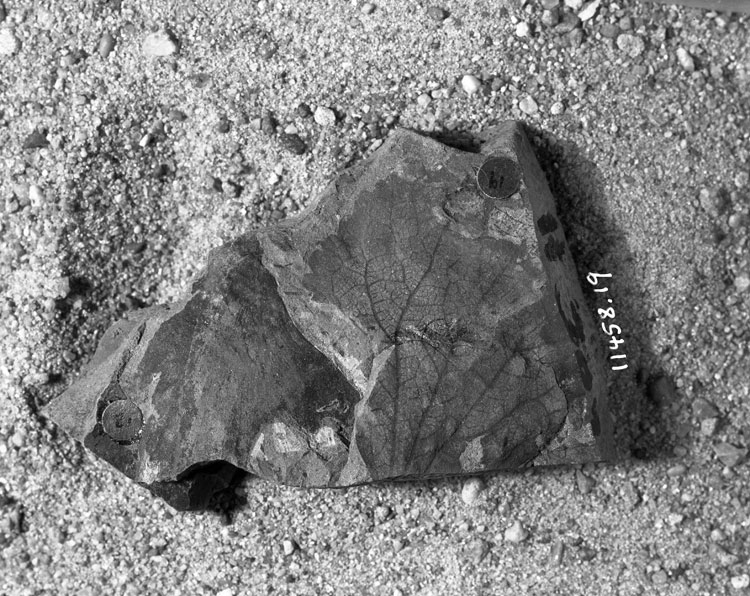Locality
USGS11614
Lat. 60° 36' 36"N Long. 164° 49' 18"W
Baird Inlet (C-8) Quad. Nelson Island.
Description
Leaf: simple; symmetrical; wide to very wide obovate; apex missing; base cuneate; margin crenate; teeth irregular in size and spacing, rounded apparently nonglandular apices and acute sinuses, margin entire near the base; venation basal acrodromous; primary midvein moderate straight or nearly so, pectinal veins arising at an angle of 20-30°, moderate, curved uniformly towards the apex or with sudden changes of curvature at the point of departure of the pectinal abmedial veins; abmedials arising at an angle of 45-50°, stout, sinuous or curved in an apical direction, looping irregularly near the margin to join superadjacent abmedial or higher order loops at an acute angle, abmedial veins often branched, basal abmedials branched abmedially therefore weak b-pectinals; b-pectinals departing at junction of a-pectinals on midvein; b-abmedials looped as in a-abmedials; superior secondary veins departing midvein at 40-45°, looped about midvein; tertiary veins stout, often percurrent, convex in the axils of vein branches becoming more or less straight, percurrent, simple or branched, between the a-pectinals and midvein, tertiaries frequently angularly convex, often branched, forming a very acute angle with the a-pectinals and midvein; third order looping present near the margin; fourth order veins stout, random reticulate; the tooth venation consisting of a second or third order medial vein with two lateral bracing third order veins that run close to and parallel to the tooth margin, the medial vein giving off fourth order lateral veins at approximately right angles.
Remarks
Details of the venation of these specimens are extremely well preserved partly due to the exceptional thickness of all vein orders, a character which makes them distinct from any other similarly organized leaf. The tooth is of particular interest; the bracing lateral veins are well developed and are characteristic of Chloranthoid type teeth found in both modern Magnoliidae and Hamamelididae. There is, however, an apparent lack of a glandular tip or cap to the tooth apex.
Bell illustrates a leaf similar to specimen USGS 11614.62 (Bell, 1949; Plate 4, Fig. 2) from the lower part of the Edmonton Formation under the name Trochodendroides arctica. Of the other specimens given this name by Bell in the same publication only GSC No. 6345 (Plate 9, Fig. 4) and GSC No. 5582 (Plate 20, Fig. 3) are considered to be of the same kind as those described here. We consider all of Bell's (1949) specimens of Paleocene age to be different in various ways including venation strength, tooth characteristics (GSC Nos. 5695 and 6114, Plate 45, Figs. 1 and 2; GSC Nos. 5918, 5581, and 5506, Plate 46, Figs. 1, 2 and 3), or basal shape (GSC Nos. 5695, 6114, and 5506). Later Bell considered his earlier specimens ascribed to Trochodendroides arctica to be the same as one described from the Newcastle Formation under the name Trochodendroides (Cercidiphyllum) arctica (Bell, 1957, p. 45). However, this specimen (GSC No. 5627, holotype of 'Populus' protozaddachi Dawson) is considerably larger, has less pronounced venation, smaller teeth in relation to the lamina width, and more regularly organized venation than any of the Alaskan leaves described here.
